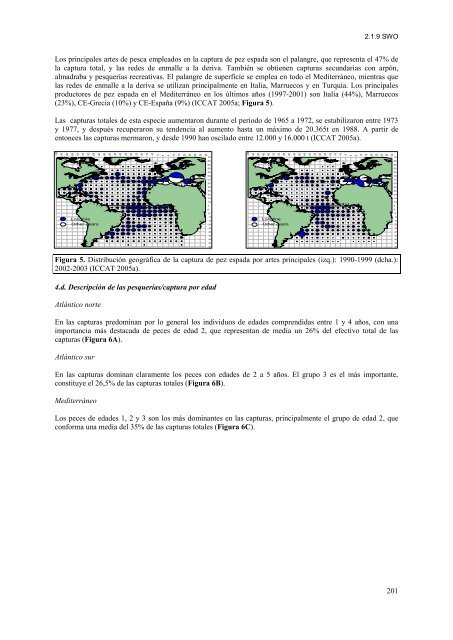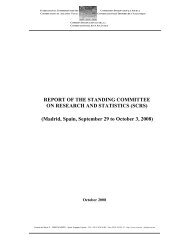- Page 3 and 4:
© ICCAT, 2010 Depósito legal: M-3
- Page 6 and 7:
1. Visión general 2. Descripción
- Page 8:
ESPECIES CUBIERTAS DIRECTAMENTE POR
- Page 11 and 12:
MANUAL DE ICCAT, 1ª Edición (Ener
- Page 13 and 14:
MANUAL DE ICCAT, 1ª Edición (Ener
- Page 15 and 16:
MANUAL DE ICCAT, 1ª Edición (Ener
- Page 17 and 18:
MANUAL DE ICCAT, 1ª Edición (Ener
- Page 19 and 20:
MANUAL DE ICCAT, 1ª Edición (Ener
- Page 21 and 22:
MANUAL DE ICCAT, 1ª Edición (Ener
- Page 23 and 24:
MANUAL DE ICCAT, 1ª Edición (Ener
- Page 25 and 26:
MANUAL DE ICCAT, 1ª Edición (Ener
- Page 27 and 28:
MANUAL DE ICCAT, 1ª Edición (Ener
- Page 29 and 30:
MANUAL DE ICCAT, 1ª Edición (Ener
- Page 31 and 32:
MANUAL DE ICCAT, 1ª Edición (Ener
- Page 33 and 34:
MANUAL DE ICCAT, 1ª Edición (Ener
- Page 35 and 36:
MANUAL DE ICCAT, 1ª Edición (Ener
- Page 38 and 39:
CAPÍTULO 2.1.2: PATUDO 2.1.2 Descr
- Page 40 and 41:
Turquía: Irigözorkinoz baligi, Ir
- Page 42 and 43:
Los siguientes cuadros resumen las
- Page 44 and 45:
3.b. Crecimiento 2.1.2 BET Los prim
- Page 46 and 47:
Tabla 2. Diferentes relaciones biom
- Page 48 and 49:
2.1.2 BET El número de huevos por
- Page 50 and 51:
2.1.2 BET de los peces. Estas espec
- Page 52 and 53:
4. Distribución y explotación 4.a
- Page 54 and 55:
2.1.2 BET La pesquería japonesa co
- Page 56 and 57:
Objetos Banco libre 2.1.2 BET Figur
- Page 58 and 59:
2.1.2 BET Guide for Fishery Purpose
- Page 60 and 61:
2.1.2 BET HAMPTON, J., K. Bigelow &
- Page 62:
2.1.2 BET SCHAEFER, K. 1996. Spawni
- Page 65 and 66:
MANUAL DE ICCAT, 1ª Edición (Ener
- Page 67 and 68:
MANUAL DE ICCAT, 1ª Edición (Ener
- Page 69 and 70:
MANUAL DE ICCAT, 1ª Edición (Ener
- Page 71 and 72:
MANUAL DE ICCAT, 1ª Edición (Ener
- Page 73 and 74:
MANUAL DE ICCAT, 1ª Edición (Ener
- Page 75 and 76:
MANUAL DE ICCAT, 1ª Edición (Ener
- Page 77 and 78:
MANUAL DE ICCAT, 1ª Edición (Ener
- Page 79 and 80:
MANUAL DE ICCAT, 1ª Edición (Ener
- Page 81 and 82:
MANUAL DE ICCAT, 1ª Edición (Ener
- Page 83 and 84:
MANUAL DE ICCAT, 1ª Edición (Ener
- Page 85 and 86:
MANUAL DE ICCAT, 1ª Edición (Ener
- Page 88 and 89:
CAPÍTULO 2.1.4: ATÚN BLANCO 2.1.4
- Page 90 and 91:
2.1.4 ALB Figura 1. Dibujo de un ej
- Page 92 and 93:
2.1.4 ALB Figura 3. Temperatura med
- Page 94 and 95:
2.1.4 ALB Lt0-1.354 Megalofonou (20
- Page 96 and 97:
2.1.4 ALB El atún blanco joven (in
- Page 98 and 99:
2.1.4 ALB Más recientemente, Santi
- Page 100 and 101:
2.1.4 ALB Las pesquerías de superf
- Page 102 and 103:
2.1.4 ALB En términos generales, l
- Page 104 and 105:
2.1.4 ALB FAO. 1994. Expert consult
- Page 106:
2.1.4 ALB SHIOHAMA, T. 1971. Studie
- Page 109 and 110:
MANUAL DE ICCAT, 1ª Edición (Ener
- Page 111 and 112:
MANUAL DE ICCAT, 1ª Edición (Ener
- Page 113 and 114:
MANUAL DE ICCAT, 1ª Edición (Ener
- Page 115 and 116:
MANUAL DE ICCAT, 1ª Edición (Ener
- Page 117 and 118:
MANUAL DE ICCAT, 1ª Edición (Ener
- Page 119 and 120:
MANUAL DE ICCAT, 1ª Edición (Ener
- Page 121 and 122:
MANUAL DE ICCAT, 1ª Edición (Ener
- Page 123 and 124:
MANUAL DE ICCAT, 1ª Edición (Ener
- Page 125 and 126:
MANUAL DE ICCAT, 1ª Edición (Ener
- Page 127 and 128:
MANUAL DE ICCAT, 1ª Edición (Ener
- Page 129 and 130:
MANUAL DE ICCAT, 1ª Edición (Ener
- Page 131 and 132:
MANUAL DE ICCAT, 1ª Edición (Ener
- Page 133 and 134:
MANUAL DE ICCAT, 1ª Edición (Ener
- Page 135 and 136:
MANUAL DE ICCAT, 1ª Edición (Ener
- Page 137 and 138:
MANUAL DE ICCAT, 1ª Edición (Ener
- Page 139 and 140:
MANUAL DE ICCAT, 1ª Edición (Ener
- Page 141 and 142:
MANUAL DE ICCAT, 1ª Edición (Ener
- Page 143 and 144:
134
- Page 145 and 146:
MANUAL DE ICCAT, 1ª Edición (Ener
- Page 147 and 148:
MANUAL DE ICCAT, 1ª Edición (Ener
- Page 149 and 150:
MANUAL DE ICCAT, 1ª Edición (Ener
- Page 151 and 152:
MANUAL DE ICCAT, 1ª Edición (Ener
- Page 153 and 154:
MANUAL DE ICCAT, 1ª Edición (Ener
- Page 155 and 156:
MANUAL DE ICCAT, 1ª Edición (Ener
- Page 157 and 158:
MANUAL DE ICCAT, 1ª Edición (Ener
- Page 159 and 160: MANUAL DE ICCAT, 1ª Edición (Ener
- Page 161 and 162: MANUAL DE ICCAT, 1ª Edición (Ener
- Page 163 and 164: MANUAL DE ICCAT, 1ª Edición (Ener
- Page 165 and 166: MANUAL DE ICCAT, 1ª Edición (Ener
- Page 167 and 168: MANUAL DE ICCAT, 1ª Edición (Ener
- Page 169 and 170: MANUAL DE ICCAT, 1ª Edición (Ener
- Page 171 and 172: MANUAL DE ICCAT, 1ª Edición (Ener
- Page 173 and 174: MANUAL DE ICCAT, 1ª Edición (Ener
- Page 175 and 176: MANUAL DE ICCAT, 1ª Edición (Ener
- Page 177 and 178: MANUAL DE ICCAT, 1ª Edición (Ener
- Page 179 and 180: 170
- Page 181 and 182: MANUAL DE ICCAT, 1ª Edición (Ener
- Page 183 and 184: MANUAL DE ICCAT, 1ª Edición (Ener
- Page 185 and 186: MANUAL DE ICCAT, 1ª Edición (Ener
- Page 187 and 188: MANUAL DE ICCAT, 1ª Edición (Ener
- Page 189 and 190: 180
- Page 191 and 192: MANUAL DE ICCAT, 1ª Edición (Ener
- Page 193 and 194: MANUAL DE ICCAT, 1ª Edición (Ener
- Page 195 and 196: MANUAL DE ICCAT, 1ª Edición (Ener
- Page 197 and 198: 188
- Page 199 and 200: MANUAL DE ICCAT, 1ª Edición (Ener
- Page 201 and 202: MANUAL DE ICCAT, 1ª Edición (Ener
- Page 203 and 204: MANUAL DE ICCAT, 1ª Edición (Ener
- Page 205 and 206: MANUAL DE ICCAT, 1ª Edición (Ener
- Page 207 and 208: MANUAL DE ICCAT, 1ª Edición (Ener
- Page 209: MANUAL DE ICCAT, 1ª Edición (Ener
- Page 213 and 214: MANUAL DE ICCAT, 1ª Edición (Ener
- Page 215 and 216: MANUAL DE ICCAT, 1ª Edición (Ener
- Page 217 and 218: MANUAL DE ICCAT, 1ª Edición (Ener
- Page 219 and 220: MANUAL DE ICCAT, 1ª Edición (Ener
- Page 221 and 222: MANUAL DE ICCAT, 1ª Edición (Ener
- Page 223 and 224: MANUAL DE ICCAT, 1ª Edición (Ener
- Page 225 and 226: 216
- Page 227 and 228: MANUAL DE ICCAT, 1ª Edición (Ener
- Page 229 and 230: MANUAL DE ICCAT, 1ª Edición (Ener
- Page 231 and 232: MANUAL DE ICCAT, 1ª Edición (Ener
- Page 233 and 234: MANUAL DE ICCAT, 1ª Edición (Ener
- Page 235 and 236: MANUAL DE ICCAT, 1ª Edición (Ener
- Page 237 and 238: MANUAL DE ICCAT, 1ª Edición (Ener
- Page 239 and 240: MANUAL DE ICCAT, 1ª Edición (Ener
- Page 241 and 242: MANUAL DE ICCAT, 1ª Edición (Ener
- Page 243 and 244: MANUAL DE ICCAT, 1ª Edición (Ener
- Page 245 and 246: MANUAL DE ICCAT, 1ª Edición (Ener
- Page 247 and 248: MANUAL DE ICCAT, 1ª Edición (Ener
- Page 249 and 250: MANUAL DE ICCAT, 1ª Edición (Ener
- Page 251 and 252: 242
- Page 253 and 254: MANUAL DE ICCAT, 1ª Edición (Ener
- Page 255 and 256: MANUAL DE ICCAT, 1ª Edición (Ener
- Page 257 and 258: MANUAL DE ICCAT, 1ª Edición (Ener
- Page 259 and 260: MANUAL DE ICCAT, 1ª Edición (Ener
- Page 261 and 262:
MANUAL DE ICCAT, 1ª Edición (Ener
- Page 263 and 264:
MANUAL DE ICCAT, 1ª Edición (Ener
- Page 265 and 266:
MANUAL DE ICCAT, 1ª Edición (Ener
- Page 267 and 268:
MANUAL DE ICCAT, 1ª Edición (Ener
- Page 270 and 271:
CAPÍTULO 2.2.1.1: TINTORERA 2.2.1.
- Page 272 and 273:
2. Identificación Figura 1. Dibujo
- Page 274 and 275:
2.2.1.1 BSH con la existencia de zo
- Page 276 and 277:
2.2.1.1 BSH sostienen un esquema m
- Page 278 and 279:
2.2.1.1 BSH palangre, o como especi
- Page 280 and 281:
2.2.1.1 BSH MEJUTO, J. and B. Garc
- Page 282 and 283:
CAPÍTULO 2.2.1.2: MARRAJO DIENTUSO
- Page 284 and 285:
2. Identificación Figura 1. Dibujo
- Page 286 and 287:
2.2.1.2 SMA mueven al norte hacia G
- Page 288 and 289:
2.2.1.2 SMA fueron otros elasmobran
- Page 290 and 291:
6. Bibliografía 2.2.1.2 SMA ANON.
- Page 292 and 293:
2.2.1.2 SMA STEVENS, J. D., 1984. B
- Page 294 and 295:
CAPÍTULO 2.2.1.3: MARRAJO SARDINER
- Page 296 and 297:
2.2.1.3 POR • La primera aleta do
- Page 298 and 299:
4. Biología 4.a. Crecimiento 2.2.1
- Page 300 and 301:
2.2.1.3 POR sardinero se encuentra
- Page 302 and 303:
2.2.1.3 POR FRANCIS, M.P. and Steve
- Page 304:
CAPÍTULO 2 - APÉNDICES
- Page 307 and 308:
MANUAL DE ICCAT, 1ª Edición (Ener
- Page 309 and 310:
MANUAL DE ICCAT, 1ª Edición (Ener
- Page 311 and 312:
MANUAL DE ICCAT, 1ª Edición (Ener
- Page 313 and 314:
MANUAL DE ICCAT, 1ª Edición (Ener
- Page 315 and 316:
302
- Page 317 and 318:
304
- Page 319 and 320:
MANUAL DE ICCAT, 1 a Edición (Ener
- Page 321 and 322:
MANUAL DE ICCAT, 1ª Edición (Ener
- Page 323 and 324:
MANUAL DE ICCAT, 1ª Edición (Ener
- Page 325 and 326:
MANUAL DE ICCAT, 1ª Edición (Ener
- Page 327 and 328:
MANUAL DE ICCAT, 1ª Edición (Ener
- Page 329 and 330:
316
- Page 331 and 332:
MANUAL DE ICCAT, 1ª Edición (Ener
- Page 333 and 334:
MANUAL DE ICCAT, 1ª Edición (Ener
- Page 335 and 336:
MANUAL DE ICCAT, 1ª Edición (Ener
- Page 337 and 338:
MANUAL DE ICCAT, 1ª Edición (Ener

















